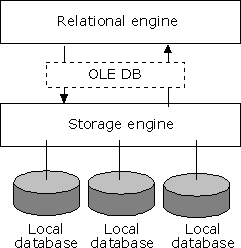
The database server of Microsoft® SQL Server™ has two main parts; the relational engine (RE) and the storage engine (SE). One of the most important architectural changes made in SQL Server version 7.0 is to clearly separate the relational and storage engine components within the server and to have them use the OLE DB API to communicate with each other.

The processing for a SELECT statement that references only tables in local databases can be briefly summarized as:
A rowset is the OLE DB term for a result set. The rowsets requested by the relational engine return the amount of data needed from a table or index to perform one of the operations used to build the SELECT result set. For example, this SELECT statement requires a table scan if it references a table with no indexes:
SELECT * FROM ScanTable
The relational engine implements the table scan by requesting one rowset containing all the rows from ScanTable.
This SELECT statement only needs information available in an index:
SELECT DISTINCT LastName
FROM Northwind.dbo.Employees
The relational engine implements the index scan by requesting one rowset containing the leaf rows from the index built on the LastName column.
This SELECT statement needs information from two indexes:
SELECT CompanyName, OrderID, ShippedDate
FROM Northwind.dbo.Customers AS Cst
JOIN Northwind.dbo.Orders AS Ord
ON (Cst.CustomerID = Ord.CustomerID)
The relational engine requests two rowsets, one for the clustered index on Customers and the other on one of the nonclustered indexes in Orders.